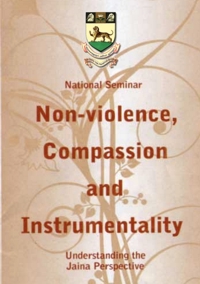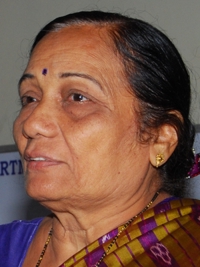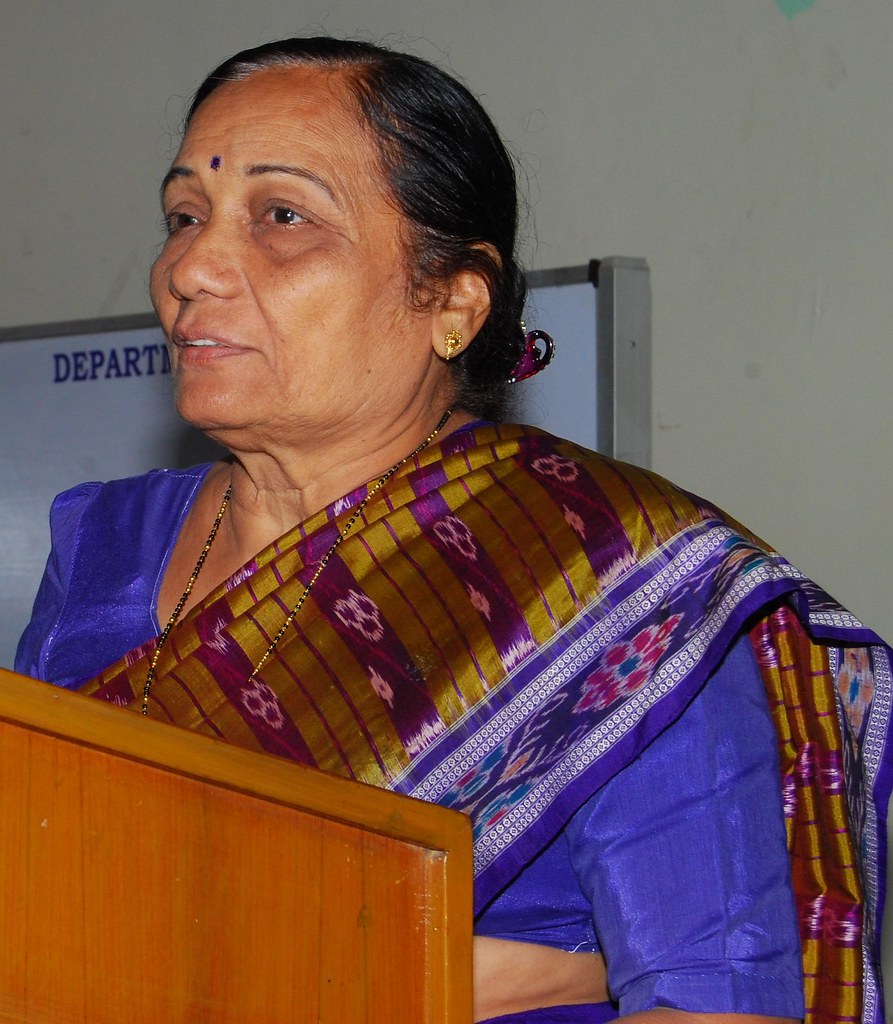Chennai 2009: Non-violence, Compassion and Instrumentality - A Jaina Perspective
 | Non-violence, Compassion and InstrumentalityA Jaina PerspectiveSeminar organized by the Department of Jainology of the University of Madras, 13 and 14 February 2009 Chennai, India |
Jain Ahiṁsā in Modern Perspective
13.2.2009
In the literature of world religions, nonviolence as a way of life has a very ancient history. Jainism is the ahiṁsā religion par excellence among others. Jainism placed strong emphasis on the ethical principle of ahiṁsā and also discussed it in epistemology and metaphysics. Ahiṁsā is the central core of Jain philosophy and religion. Ahiṁsā can not be practiced without the anekānta point of view. Violence or nonviolence depend upon the attitude of the doer. If outward violence is considered as violence, then nobody is nonviolent in this world because there is life everywhere in the world and it is destroyed continuously. Therefore an alert person has ahiṁsā in his nature, and one who is not alert, has hiṁsā in his nature.
Jains speak of violence as unnatural and nonviolence as natural because if you throw somebody into the river, you expect a cause for it, but if you save a man from drowning into a river, we do not require an explanation for it. It means that love or nonviolence is inherent in the nature of things. Nonviolence is as natural as the good smell to a flower. A flower emits a pleasant smell unmindful of the fact whether the smell is desirable to others or not, and whether those who receive it are grateful to him or not. Its good smell is not conditional. It is unconditional and unmindful of its surroundings. Nonviolence is the intrinsic nature of man. It is therefore not dependent even on the existence of the other, not to speak of the action of others.
Harmony between different fields
Jainism is not an abstract philosophy, but a complete life-style, a way of life. It offers physical, moral and spiritual rules of healthy living. The latest techniques and the best of science can be incorporated in the Jaina model while reviving the old tradition. It establishes harmony between religious and scientific, spiritual and physical aspects, between personal independence and ecological interdependence. It is the path of purification, the basis of which is the principle of nonviolence which is the principle pertaining to environment.
According to Jainism, true religion is that which sustains all species of life and helps to maintain harmonious relationship among them. In the Āchāraṅga Sūtra it is said, “Ahiṁsā is the pure and eternal Dharma.”[1] Non-violence is not restricted to human beings but it embraces the whole universe. Non-violence is observed by Jaina seers to be a law of nature. Abstinence from killing others must be observed in thought, word and deed. The mere thought of killing is as immoral as actually killing. Hence, according to Jains, the principle of ahiṁsā naturally implies purity of thought, word and deed actuated by universal love and mercy. There are 108 types of violence as analyzed in Jainism. Yet:
- Jain ahiṁsā has been extended towards sub-human life rather than human life. The popular meaning of Jain ahiṁsā is such that the human being has almost been forgotten. Jain ahiṁsā can be defined as reverence for all organic life.
- The Jains seem to think in certain connections that mere biological survival is the supreme ethical value.
- Moreover, new forms of violence like exploitation of others have not been discussed in Jainism
Mahatma Gandhi on Mahavira
In the words of Gandhi: “No religion of the world has explained the principle of ahiṁsā so deeply and scientifically as is discussed with its applicability in every human life in Jainism. As and when the benevolent principle of ahiṁsā or nonviolence will be ascribed for practice by the people of the world to achieve their end of life in this world and beyond, Jainism is sure to have the uppermost status and Lord Mahavira is sure to be respected as the greatest authority on ahiṁsā.”
Yet there are certain differences. Gandhi interprets:
Nonviolence as an active force of the highest order. It is counter-posing “soul-force” against “physical force.” One who lacks “strength of the spirit” can not be non-violent. Gandhi considers weakness, cowardice and fear as sins against the human spirit. He said: “My creed of nonviolence is an extremely active force. It has no room for cowardice or even weakness. There is hope for a violent man to be non-violent, but there is none for a coward”. [2] Gandhi did not distinguish between śramanas, munis and śravakas - the householders. As far as practice of ahiṁsā is concerned, Jainism has differentiated the two.
Yet Gandhi was influenced in his personal and political life by the Jain concept of nonviolence in his quest for freedom. Probably it is only in India that a political resolution was brought forward through moral persuasion.
Gandhi’s ahiṁsā in social context
Gandhi’s concept of ahiṁsā implies at least 3 principles[3]:
Āchārya Kripalani grades four levels of nonviolence from the Gandhian criterion of human dignity:
Truth and nonviolence inconvertible terms
Gandhi applies ahiṁsā for reconstructing the society. The Gandhian concept of ahiṁsā is based on Truth. But Gandhi believes that there can be no Truth without nonviolence and so he maintains that in an indirect way nonviolence is implied in Truth. It was this truth that Gandhi held fast all his life.
Gandhi found that the nearest approach to God is through love in the sense of ahiṁsā. Nonviolence or love has the same relation to Truth in Gandhi’s intuitive theory of reality as ‘perception’ has to ‘idea’ in Kant’s critical theory of knowledge. Gandhi’s variation of Kant’s famous dictum: “Perception without idea is blind and idea without perception is empty” was: “Love without truth is blind and truth without love is empty.”[4] Gandhi calls himself a seeker after Truth. Truth cannot be realized without nonviolence. Means and ends being convertible terms - as Gandhi insisted truth and nonviolence become a part of the spiritual make up of Gandhian ahiṁsā. He says. ‘Truth is God: nonviolence is the means of realizing him. As a rule, life depends on nonviolence and not on violence; nonviolence is the very condition of physical existence. But just as ‘dog bites man’ is no news but ‘man bites dog’ is news, we tend to notice the use of violence more quickly than that of nonviolence.
Journey towards nonviolence
Nonviolence as a concept is getting greater validation from scientific studies of the modern cities of man and nature of international relations. Scientists as well as philosophers have supported the feeling that the course of evolution in human society and culture is directed towards the emergence of a unified humanity based on universal love. Julian Huxley is of the opinion that from the biological point of view, the evolution of man ceased millions of years ago and yet evolution is still going on.
The level of human consciousness has increased since the first humanoid walked on earth. Today, man is more prone to adjustment and rational solutions of the vexing social issues; the tendency to react emotionally towards problems engendering social conflict has been reduced. Although conflict and exploitation of fellow human beings on the basis of racial and ideological prejudices still exist and nothing can be said definitely about the course of the future pattern, yet there is pragmatic ground to surmise that within a range of certain probability the course of evolution in the culture of man points towards an era of increasing international cooperation and peace based on nonviolence. World peace and non-violent social order may be realized from the effect of what Kant called “unsociable sociability” of man rather than by man’s sudden transformation into a superman. [5]
Positive and negative senses of ahiṁsā
Gandhi used the word in the widest possible sense and distinguished between its negative and positive senses in the following words, “In the negative form, it means not injuring any living being whether by body or mind. I may not, therefore hurt the person or any wrongdoer or bear any ill will to him and so cause him mental suffering. This statement does not cover suffering caused to the wrongdoer by natural acts by me which do not proceed from an ill will. Ahiṁsā requires deliberate self-suffering; not a deliberate injuring of the supposed wrongdoer … In its positive form ahiṁsā means the largest love, the greatest charity. If I am a follower of ahiṁsā, I must love my enemy or a stranger to me as I would my wrong-doing father or son. This active ahiṁsā necessarily includes truth and fearlessness.[6]
According to Gandhi, a follower of true ahiṁsā must always be ready to die without any desire ever to hurt or kill anyone.
Gandhi understood ahiṁsā as a positive principle which can be described by the words ‘love’ (prema), ‘friendliness’ (maitri), ‘regard for life,’ etc. In Gandhian ethics the whole weight falls on positive ethics even when the terms are negative.
The creed of ahiṁsā presupposes the existence of an immortal essence in the human personality. It is the recognition of this essence which gives man the courage of readiness to die without any intention to kill, which is the essence of ahiṁsā according to Gandhi. Nonviolence is possible only by the strength of the soul. Thus Gandhi has taken ahiṁsā as a weapon of the strong and not of the weak and the coward. Cowardice and ahiṁsā are contradictory terms, according to Gandhi.
Nonviolence at all levels
Gandhi applied nonviolence not only at the individual level, but also at the social, economic, political and cultural level. Jainism has a thought of ahiṁsā on the individual, moral and religious point of view.
For nonviolent reconstruction of the society, Gandhi fought to the last the social evils of the Indian society, i.e. untouchablity, child-marriage, the dowry-system, and championed the cause of equality of women and dignity of labor. The concept of nonviolence used by Gandhi was a kind of social gravitation. He tried to establish an integrated society based on mutual cooperation. In Young India of Aug. 4, 1927, he wrote, “I am endeavouring to see God through the service of humanity, for I know God is neither in heaven nor down below, but is in everyone.” Gandhi’s love of humanity was far-reaching. He neither believed in man-made frontiers nor in the idea of inferior and superior races.
Injustice is the root cause of all international conflicts; so positive action for peace is to be related to the efforts to establish justice, which is impossible without social change. The fundamental, necessary and urgent means for bringing about peace is the work of global justice, of the reconstructing societies, which in turn involves the transformation of man.
He applied nonviolence in the economic field, and for reconstruction in every field, he gave 18 constructive programs. For a nonviolent society, he spoke of decentralized economy and small scale industries for the freedom of man. Gandhi defined wealth in a completely different manner. Anything (art, intelligence, labor, love etc.) that a person possesses is wealth. Everyone has wealth in one form or the other. Therefore, one has not to eliminate classes, but only inequality or disparity.
The nonviolent economic structure given by Gandhi implies self-sufficiency and decentralization. The fear about it is that it may result in an increased nationalism, which in turn would nullify the present efforts of humankind to unite under one international control.
To cooperate with one another it is not necessary to be dependent on one another. Two healthy individuals should cooperate with one another, rather than Saṁkhya’s idea of cooperation between the lame and blind man. Let the village be one family. The taluka behaves like one village, the district like one taluka, the state like one district, the nation like one state, and let there be one nation, i.e. the whole world. Therefore Āchārya Vinoba Bhave gave the slogan of Jaijagat.
He warns us: “A nonviolent system of government is clearly an impossibility as long as the wide gulf between the rich and hungry millions persists.” Gandhi had no time to strive for economic equality at the social level. Āchārya Vinoba Bhave tried to bring economic equality by Bhoodan and Gramdan.
Perhaps Gandhi is right in thinking that centralized finance, mass production, centralized organization of government and society, technology and planning are not conducive to peace among nations or men. Aldous Huxley at least thought that Gandhi was right. [7]
In the political field, Gandhi talked of village self-rule on the one hand and the world-state on the other. He uses Christian terminology, the kingdom of common people, but when it is the kingdom of common people, it becomes uncommon.
On July 7, 1946 he wrote in the Harijan: “War is the product of envy, ill-will and misunderstanding between nations. The factors that lead nations to war are the same as those that lead individuals to moral and spiritual degradation. We have to make truth and nonviolence not matters for mere individual practice but for practice by groups and communities and nations.” Gandhi holds that war can be abolished for ever, and peace and harmony can be established between nations by an extension of the principle of truth and nonviolence.
The application of nonviolence in the social field made the greatest cultural impact on Indian life. He stressed the importance of tolerance as the main basis of culture.
Thus Gandhi gave a wider connotation to the term “ahiṁsā.” He elaborated the concept of liberation (spiritual) in all its aspects and for all. He did not make artificial compartments of life, but conceived of life as an integrated whole. Gandhi tried to develop an all-inclusive and universal culture through truth and nonviolence. His idea of culture was based on tolerance and activism. Therefore, he said, “I do not want my house to be walled in on all sides and my windows to be stuffed. I want the cultures of all lands to be blown about my house as freely as possible. But I refuse to be blown off my feet by any.”[8]
Nonviolence and ecology
There were not many ecological problems during the time of Mahavira, but today it is a problem touching our very survival. Ecological problems are rooted in violence. Because of the actions of men, today there is ecological imbalance damaging the precious biosphere. For the sake of materialistic growth all laws of ecology are broken. In the name of progress, human beings have emptied so many resorts of nature. Man’s victory over nature by destroying plant and animal life and the resultant pollution of earth, water and air, the ozone depletion, acid rain, the greenhouse effect, are some of the things disturbing the ecological balance due to violent acts such as deforestation, cutting of trees etc., while animals and other elements of the biodiversity become extinct.
In India we find the Gandhian movement for world peace and nonviolent society being kept on or even extended to cover new areas of social problems by Āchārya Vinoba Bhave In the west, the Quakers still preserve and propagate the ethical values of nonviolence which had its history in primitive Christianity or even the Jewish sect of the Essenes. In social science there are the pioneering researches of Pitrim Sorokin on “creative altruism.” In man is an example of a rational approach to strengthen the moral basis of society for the establishment of a nonviolent society.
Mahatma Gandhi characterized modern civilization as a great disease and a nine days wonder, for it takes note neither of morality nor of religion. Growing materialism has led to moral ruin and has been responsible for violence and war. It must be noted that unless the people of the world learn and accept the principle of peaceful co-existence regardless of cast and creed and political or any ideology, there can neither be genuine peace nor progress.
Ahiṁsā in the Mahābhārata - and Gandhi, by V.M. Bedekar, an article in Gandhi Marg. Vol. II 119-125.
Traditions of Nonviolence, T. K. Unnithan and Yogendra Singh, New Delhi: Arnold Heinemann, 1973, p.308.
 Dr. Geeta Mehta
Dr. Geeta Mehta
